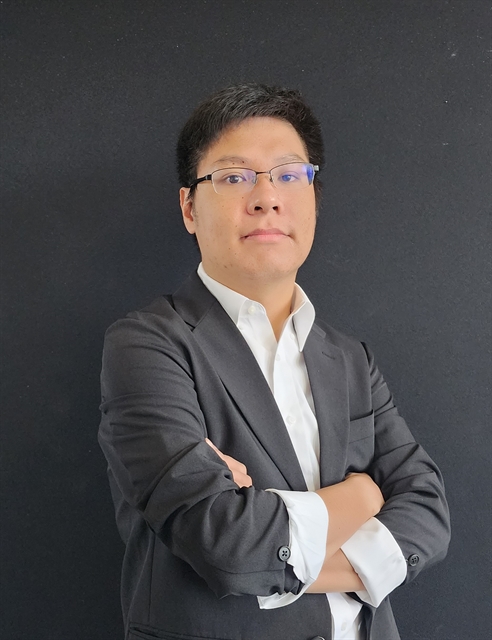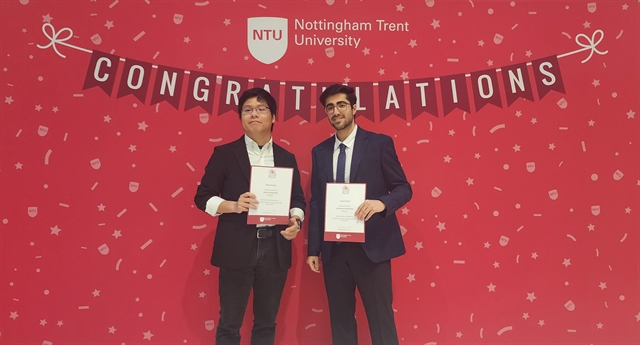 Inner Sanctum
Inner Sanctum

 |
| PIONEER: Lã Mạnh Tường is currently a graduate student in construction management at Nottingham Trent University (NTU). Photo courtesy of Lã Mạnh Tường |
It took Vietnamese master's student Lã Mạnh Tường, just seven months to take Việt Nam to new heights in construction. Through pioneering multipurpose construction solutions, Tường, 29, and his team successfully competed against 50 others and advanced to the final of the Global Student Challenge competition. Việt Nam News reporter Hoàng Hồ talks with Tường about his journey.
Inner Sanctum: Can you explain your project, its goal, and how it applies to daily life?
Our project is a multipurpose building that offers community engagement, education, cultural enrichment, professional development, and environmental benefits. It serves as an advising community centre, conference hall, exhibition centre, and design-build construction centre. The building provides various services, including workshops, seminars, and events catering to the local community. It also serves as a resource for research and education, promoting cultural exchange and social interaction. The exhibition centre showcases art exhibits, and the design-build construction centre provides hands-on training for university students. The building features sustainable design and construction practices, resource conservation features, and encourages sustainable transportation.
Inner Sanctum: How did you feel when your team got to the final of the competition?
Our initial goal was to go as far as we could, and we saw this project as an opportunity to showcase the potential of building this complex to the school administration. Nottingham Trent University aims to make it a reality in the not-too-distant future. Therefore, being the top finalist makes us feel like an opportunity has opened up before us. We did it brilliantly.
Inner Sanctum: Can you share your passion for the field? Did you have any difficulties during the competition?
Despite its reputation for being a difficult field, I find construction fascinating. I enjoy the challenges of planning, designing, and building functional and aesthetically pleasing structures. The process of transforming raw materials into a finished product is incredibly rewarding, and I find it inspiring to see how a group of skilled professionals can come together to create something that will stand the test of time. In short, I am passionate about construction because it requires a unique combination of creativity, practicality, and attention to detail.
I believe that the most difficult thing is getting used to the new format of the contest. This year, the organisers used a new format that requires participating teams to apply their knowledge and create products of pure expertise such as design, cost estimation, and construction organisation. They also ask teams to create and run a fictional company throughout the project. This makes it a bit difficult for the members when most of them are pure professionals and do not have a business management mindset. Along with the above difficulty is that we need to be familiar with the environment and culture of the UK when researching the location for our project.
 |
| AWARDED: Lã Mạnh Tường (left) and his teammate Siavash Shamsi at the NTU's Scholarship Awards Celebration. Photo courtesy of Nottingham Trent University |
Inner Sanctum: What are the requirements and challenges in reaching sustainable construction? Does Việt Nam have the potential to reach the level of the UK?
Sustainable construction requires a comprehensive approach that takes into consideration various aspects, including design, materials, energy efficiency, and waste management. It involves adopting green building practices that reduce the environmental impact of construction activities. The challenges in achieving sustainable construction include high upfront costs, a lack of awareness and understanding among stakeholders, limited availability of green building materials and technologies, and the need for specialised knowledge and skills. However, with the right policies, incentives, and education, sustainable construction can become more accessible and widespread, resulting in significant environmental and economic benefits.
Việt Nam has made significant progress recently towards sustainable construction, but it may take some time for the country to reach the level of the UK. The UK has been at the forefront of green building practices for two decades, with a well-established regulatory framework and a strong culture of sustainability. However, Việt Nam has recognised the importance of sustainable construction and has taken steps towards promoting green building practices. The Government has developed a green building certification system and introduced policies and incentives to encourage sustainable practices.
Inner Sanctum: Do you plan to apply this model to Việt Nam?
A complex university building like our project can positively impact Việt Nam's education and cultural landscape, as well as the local community.
The counseling centre can provide valuable services to students and the community, while also allowing students to apply what they have learned in a real-world setting.
The international conference centre can draw high-profile events and speakers, therefore bringing more high-quality events and promoting Việt Nam as a destination for global conferences in the future. The exhibition areas can provide opportunities for students to showcase their work and promote their ideas, while also serving as a space for cultural events and exhibitions. The outdoor campus and green roof can provide a much-needed oasis in the city, creating a space for relaxation, recreation, and community building.
To build a model like this in Việt Nam, it would be important to engage with stakeholders, including universities, local governments, and the community, to ensure that the design and features of the complex are appropriate for local needs and preferences. Funding mechanisms, such as public-private partnerships or grants, may be necessary to finance the construction and maintenance of the complex.
Inner Sanctum: From your experience in the UK, do you have any advice for the next generation of construction students?
By being in the last age group of Generation Y, I have had many opportunities to reach out to the young people of Generation Z, who are part of the next generation of civil engineering students. From my point of view, they are dynamic, creative young people who have a viable approach to problems, foreign languages, and the ability to master IT faster than previous generations.
However, there is one element that today's younger generations lack compared to their predecessors. It is the spirit of learning and searching. Through many years of approaching the environment and working with many international clients, I find the most important thing when working with them is to show the spirit and attitude of inquisitiveness and willingness to listen to others’ opinions and have a humble attitude at work. Knowledge and skills can be cultivated over time, if there are conditions to go abroad to study and practice, it is also a good thing. However, it is the right attitude to work that will bring you success. VNS




